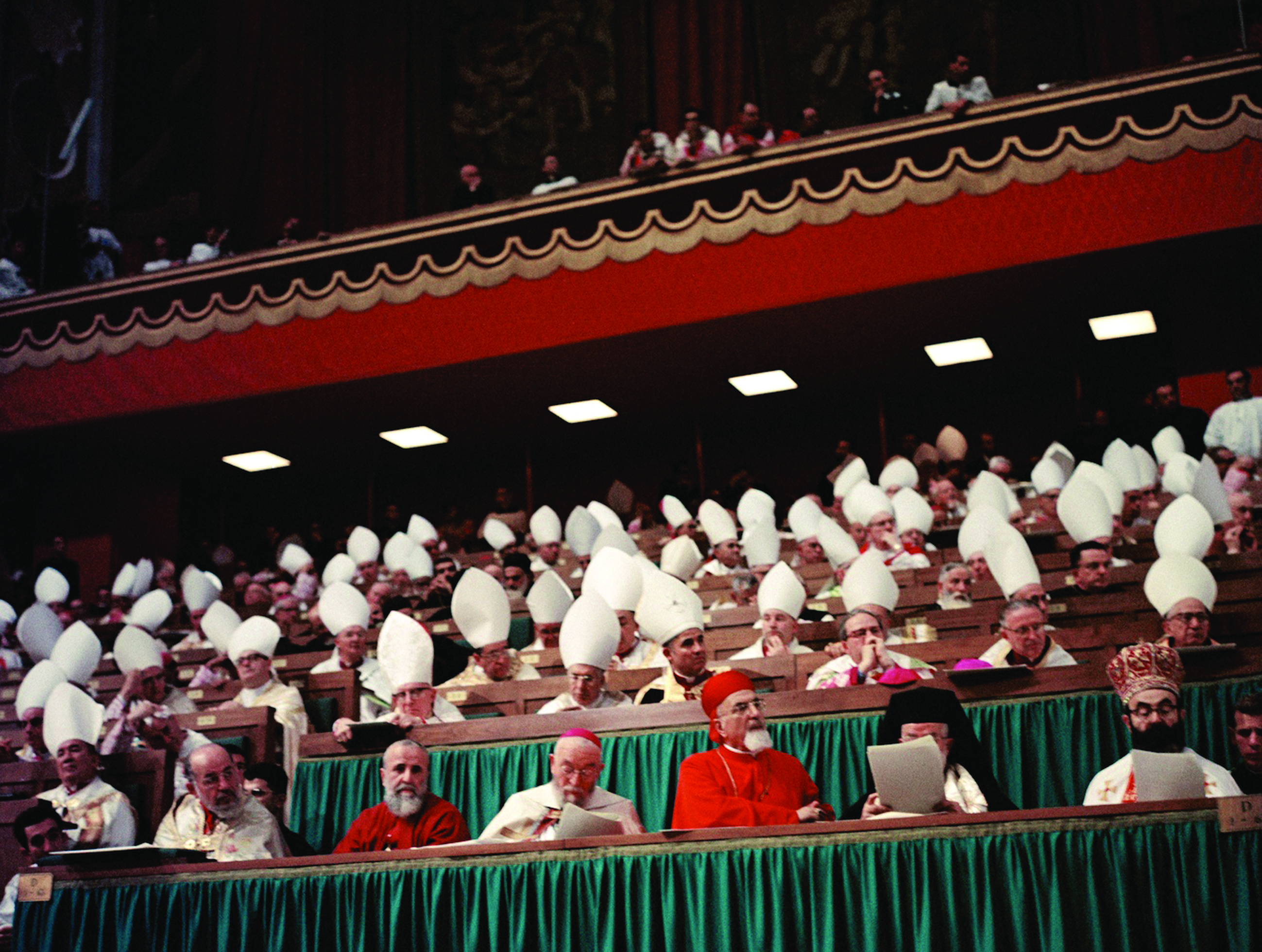 Archbishop Carlo Maria Viganò has sparked a new discussion of what Vatican II has done to the Church — and whether the Council can be salvaged
Archbishop Carlo Maria Viganò has sparked a new discussion of what Vatican II has done to the Church — and whether the Council can be salvaged
By Christina Deardurff
Since gaining celebrity in 2018 as a “whistleblower” of sorts in the sexual abuse case of the ebullient and influential American prelate, then-Cardinal Theodore McCarrick, Archbishop Carlo Maria Viganò, former Apostolic Nuncio to the U.S., has had the ear of much of the Catholic world and beyond.
Making what some consider impertinent, and even shocking, claims and proposals, he has called on Pope Francis to resign, said the Freemasons are in control of the Vatican, and, in his latest salvo against what he sees as a web of distortion and corruption in the Church, suggested in a June 2020 essay that the 1960s Vatican Council II has resulted in a “parallel Church” that was “built, superimposed over and diametrically opposed to the true Church of Christ.”
Criticisms of the Second Vatican Council began while the ink was still drying on its documents, and they have continued throughout the intervening decades. Many found something arresting in Archbishop Viganò’s analysis, perhaps because it seemed to forthrightly explain the Council as the one principle of coherent explanation among disparate occurrences that have been so troubling to so many Catholics.
Steve Skojec, editor of the OnePeterFive website, went so far as to say, “In today’s text [by Viganò], we see the calmest, most succinct, most direct acknowledgment of what the Second Vatican Council has wrought that I have ever read from a member of the episcopacy,” and he called the letter “historic.”
Others were not so sanguine about Archbishop Viganò’s thesis. CNA’s J.D. Flynn opined July 1 that Archbishop Viganò’s comments may even reach the level of either heresy or schism, saying such a conclusion is “subject only to the judgment of the Holy See.”
The archbishop used as a springboard for his June 9 essay a previous essay, published June 1, also on LifesiteNews, by Archbishop Athanasius Schneider of Kazakhstan, which posited that, seemingly contrary to a pronouncement of Pope Francis that “Diverse religions are willed by God,” that, in fact, “There is no divine positive will or natural right to the diversity of religions.”
Archbishop Schneider went on to lay the misunderstanding at the feet of Vatican II’s document on world religions, Nostra Aetate, which, he said, because of its ambiguity allowed for this confusion.
According to Archbishop Viganò, such confusion is symptomatic of much of the outcome of Vatican II from 1965 until today.
This is not a new idea. Critics of the state of the Church over the past few decades have pointed again and again to Vatican II documents which, they say, have been fatally compromised by ambiguity — Archbishop Viganò in fact called it a studied ambiguity — and have led inexorably to misunderstanding, misinterpretation, and eventually loss of belief in some doctrines that Church “progressives” have found uncongenial to their views.
The five Popes of the Council: John XXIII, who summoned the Council in early 1959, shortly after his 1958 election; Paul VI, who continued the Council after John died in 1963, and saw it to its conclusion, then spent 15 years “implementing” it; John Paul II and Benedict XVI, who attended the Council, one as bishop of Krakow, the other as a theological expert, then tried as Popes to interpret it “correctly”; and Francis. Not shown: John Paul I, who ruled only 33 days in 1978
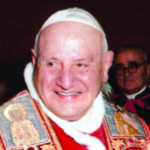
What has been less common until now is the Archbishop’s suggestion that the “hermeneutic of continuity” preached by Pope Benedict, and implicitly, by Pope John Paul II, which was to be a guide to rescuing Vatican II from those who would use it to introduce false doctrines, has “proven unsuccessful.”
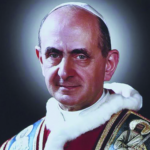 When asked by Catholic Culture’s Phil Lawler, “What is the solution?” Archbishop Viganò answered, “It will be for one of [Francis’] Successors, the Vicar of Christ, in the fullness of his apostolic power, to rejoin the thread of Tradition there where it was cut off. This will not be a defeat but an act of truth, humility, and courage. The authority and infallibility of the Successor of the Prince of the Apostles will emerge intact and reconfirmed.”
When asked by Catholic Culture’s Phil Lawler, “What is the solution?” Archbishop Viganò answered, “It will be for one of [Francis’] Successors, the Vicar of Christ, in the fullness of his apostolic power, to rejoin the thread of Tradition there where it was cut off. This will not be a defeat but an act of truth, humility, and courage. The authority and infallibility of the Successor of the Prince of the Apostles will emerge intact and reconfirmed.”
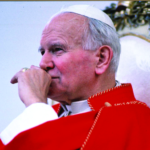 It was an answer that set off alarm bells in the minds of many, even some of Archbishop Viganò’s ardent sympathizers. How could he imply so clearly that the Second Vatican Council must be discarded — and would this mean that the Council itself was not valid? “I have never thought and even less have I affirmed that Vatican II was an invalid Ecumenical
It was an answer that set off alarm bells in the minds of many, even some of Archbishop Viganò’s ardent sympathizers. How could he imply so clearly that the Second Vatican Council must be discarded — and would this mean that the Council itself was not valid? “I have never thought and even less have I affirmed that Vatican II was an invalid Ecumenical
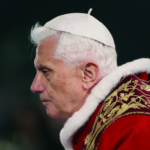 Council: in fact, it was convoked by the supreme authority, by the Supreme Pontiff, and all of the Bishops of the world took part in it,” Archbishop Viganò replied July 3, in yet another open missive. “Vatican II is a valid Council, supported by the same authority as Vatican I and Trent. However, as I have already written, from its origin it was made the object of a grave manipulation by a fifth column that penetrated into the very heart of the Church that perverted its purposes, as confirmed by the disastrous results that are before everyone’s eyes,” he said.
Council: in fact, it was convoked by the supreme authority, by the Supreme Pontiff, and all of the Bishops of the world took part in it,” Archbishop Viganò replied July 3, in yet another open missive. “Vatican II is a valid Council, supported by the same authority as Vatican I and Trent. However, as I have already written, from its origin it was made the object of a grave manipulation by a fifth column that penetrated into the very heart of the Church that perverted its purposes, as confirmed by the disastrous results that are before everyone’s eyes,” he said.
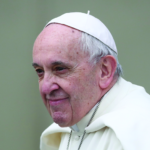 In the following pages, Inside the Vatican takes a look at more of Archbishop Viganò’s comments about Vatican II and its aftermath, as well as varied analyses by Cardinal Walter Brandmüller, Dr. Anthony Esolen, Fr. Thomas Weinandy, and Dr. John Cavadini, as part of an ongoing exploration of whether Vatican II has indeed fulfilled the hope Pope St. John XXIII expressed at the opening of the Council: “What is needed, and what everyone imbued with a truly Christian, Catholic and apostolic spirit craves today, is that this doctrine shall be more widely known, more deeply understood, and more penetrating in its effects on men’s moral lives.”
In the following pages, Inside the Vatican takes a look at more of Archbishop Viganò’s comments about Vatican II and its aftermath, as well as varied analyses by Cardinal Walter Brandmüller, Dr. Anthony Esolen, Fr. Thomas Weinandy, and Dr. John Cavadini, as part of an ongoing exploration of whether Vatican II has indeed fulfilled the hope Pope St. John XXIII expressed at the opening of the Council: “What is needed, and what everyone imbued with a truly Christian, Catholic and apostolic spirit craves today, is that this doctrine shall be more widely known, more deeply understood, and more penetrating in its effects on men’s moral lives.”
Archbishop Viganò on Vatican Council II
Excerpts from some of his recent essays
Viganò Essay of June 9, 2020
The Council was used to legitimize the most aberrant doctrinal deviations, the most daring liturgical innovations, and the most unscrupulous abuses, all while Authority remained silent…
I confess it with serenity and without controversy: I was one of the many people who, despite many perplexities and fears which today have proven to be absolutely legitimate, trusted the authority of the Hierarchy with unconditional obedience. In reality, I think that many people, including myself, did not initially consider the possibility that there could be a conflict between obedience to an order of the Hierarchy and fidelity to the Church herself…
On March 13, 2013, the mask fell from the conspirators, who were finally free of the inconvenient presence of Benedict XVI and brazenly proud of having finally succeeded in promoting a Cardinal who embodied their ideals, their way of revolutionizing the Church, of making doctrine malleable, morals adaptable, liturgy adulterable, and discipline disposable. And all this was considered, by the protagonists of the conspiracy themselves, the logical consequence and obvious application of Vatican II, which according to them had been weakened by the critiques expressed by Benedict XVI. The greatest affront of that Pontificate was the liberally permitting the celebration of the venerated Tridentine Liturgy, the legitimacy of which was finally recognized, disproving fifty years of its illegitimate ostracization…
It is no accident: what these men affirm with impunity, scandalizing moderates, is what Catholics also believe, namely: that despite all the efforts of the hermeneutic of continuity which shipwrecked miserably at the first confrontation with the reality of the present crisis, it is undeniable that from Vatican II onwards a parallel church was built, superimposed over and diametrically opposed to the true Church of Christ. This parallel church progressively obscured the divine institution founded by Our Lord in order to replace it with a spurious entity, corresponding to the desired universal religion that was first theorized by Masonry. Expressions like new humanism, universal fraternity, dignity of man, are the watchwords of philanthropic humanitarianism which denies the true God, of horizontal solidarity of vague spiritualist inspiration and of ecumenical irenism that the Church unequivocally condemns. “Nam et loquela tua manifestum te facit [Even your speech gives you away]” (Mt 26:73): this very frequent, even obsessive recourse to the same vocabulary of the enemy betrays adherence to the ideology he inspires; while on the other hand, the systematic renunciation of the clear, unequivocal, and crystalline language of the Church confirms the desire to detach itself not only from the Catholic form but even from its substance.
What we have for years heard enunciated, vaguely and without clear connotations, from the highest Throne, we then find elaborated in a true and proper manifesto in the supporters of the present Pontificate: the democratization of the Church, no longer through the collegiality invented by Vatican II but by the synodal path inaugurated by the Synod on the Family; the demolition of the ministerial priesthood through its weakening with exceptions to ecclesiastical celibacy and the introduction of feminine figures with quasi-sacerdotal duties; the silent passage from ecumenism directed towards separated brethren to a form of pan-ecumenism that reduces the Truth of the One Triune God to the level of idolatries and the most infernal superstitions; the acceptance of an interreligious dialogue that presupposes religious relativism and excludes missionary proclamation… the progressive legitimization of all that is politically correct: gender theory, sodomy, homosexual marriage, Malthusian doctrines, ecologism, immigrationism… If we do not recognize that the roots of these deviations are found in the principles laid down by the Council, it will be impossible to find a cure.
American Catholic journalist Phil Lawler (photo) interviewed Viganò on June 26. Viganò replied (excerpts):
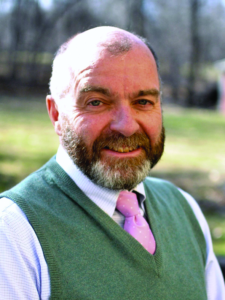 I do not think that it is necessary to demonstrate that the Council represents a problem: the simple fact that we are raising this question about Vatican II and not about Trent or Vatican I seems to me to confirm a fact that is obvious and recognized by everyone. In reality, even those who defend the Council with swords drawn find themselves doing so apart from all the other previous ecumenical councils, of which not even one was ever said to be a pastoral council. And note that they call it “the Council” par excellence, as if it was the one and only council in the entire history of the Church, or at least considering it as an unicum whether because of the formulation of its doctrine or for the authority of its magisterium. It is a council that, differently from all those that preceded it, called itself a pastoral council, declaring that it did not want to propose any new doctrine, but which in fact created a distinction between before and after, between a dogmatic council and a pastoral council, between unequivocal canons and empty talk, between anathema sit and winking at the world.
I do not think that it is necessary to demonstrate that the Council represents a problem: the simple fact that we are raising this question about Vatican II and not about Trent or Vatican I seems to me to confirm a fact that is obvious and recognized by everyone. In reality, even those who defend the Council with swords drawn find themselves doing so apart from all the other previous ecumenical councils, of which not even one was ever said to be a pastoral council. And note that they call it “the Council” par excellence, as if it was the one and only council in the entire history of the Church, or at least considering it as an unicum whether because of the formulation of its doctrine or for the authority of its magisterium. It is a council that, differently from all those that preceded it, called itself a pastoral council, declaring that it did not want to propose any new doctrine, but which in fact created a distinction between before and after, between a dogmatic council and a pastoral council, between unequivocal canons and empty talk, between anathema sit and winking at the world.
In this sense, I believe that the problem of the infallibility of the Magisterium (the inerrancy you mention is properly a quality of Sacred Scripture) does not even arise, because the Legislator, that is, the Roman Pontiff around whom the Council was convened, solemnly and clearly affirmed that he did not want to use the doctrinal authority which he could have exercised if he wanted.
I would like to make the observation that nothing is more pastoral than what is proposed as dogmatic, because the exercise of the munus docendi in its highest form coincides with the order that the Lord gave to Peter to feed his sheep and lambs. It is painful to recognize that the practice of having recourse to an equivocal lexicon… invaded the Church starting with Vatican II.
John-Henry Westen, editor of Lifesitenews, in a July 1 letter, asked Viganò to clarify his position on Vatican II. Viganò’s response was published on July 3, 2020 (excerpts)
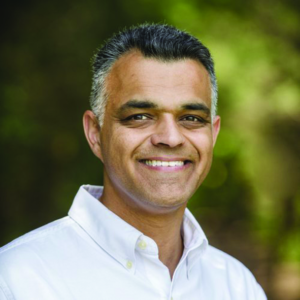 Dear John-Henry,
Dear John-Henry,
I thank you for your letter, with which you give me the opportunity to clarify what I have already expressed about Vatican II. This delicate argument is involving prominent persons of the ecclesiastical world and not a few erudite laity: I trust that my modest contribution can help to lift the blanket of equivocations that weighs on the Council, thus leading to a shared solution.
You begin with my initial observation: “It is undeniable that from Vatican II onwards a parallel church was built, superimposed over and diametrically opposed to the true Church of Christ,” and then quote my words about the solution to the impasse in which we find ourselves today: “It will be for one of his Successors, the Vicar of Christ, in the fullness of his apostolic power, to rejoin the thread of Tradition there where it was cut off. This will not be a defeat but an act of truth, humility, and courage. The authority and infallibility of the Successor of the Prince of the Apostles will emerge intact and reconfirmed.”
You then state that my position is not clear – “whether you believe Vatican II to be an invalid council and thus to be completely repudiated, or if you believe that while a valid council it contained many errors and the faithful would be better served by having it forgotten about.” I have never thought and even less have I affirmed that Vatican II was an invalid Ecumenical Council: in fact, it was convoked by the supreme authority, by the Supreme Pontiff, and all of the Bishops of the world took part in it. Vatican II is a valid Council, supported by the same authority as Vatican I and Trent.
However, as I have already written, from its origin it was made the object of a grave manipulation by a fifth column that penetrated into the very heart of the Church that perverted its purposes, as confirmed by the disastrous results that are before everyone’s eyes.
Let us remember that in the French Revolution, the fact that the Estates-General were legitimately convoked on May 5, 1789, by Louis XVI did not prevent things from escalating into the Revolution and the Terror (the comparison is not out of place, since Cardinal Suenens called the conciliar event “the 1789 of the Church”)…
The Second Vatican Council:
Difficulties of Its Interpretation
Cardinal Brandmüller Defends the “Hermeneutic of Continuity”
Excerpts from an Address Given by Cardinal Walter Brandmüller, former President of the Pontifical Committee for Historical Sciences, to the Ecclesia Mater School, August 2019
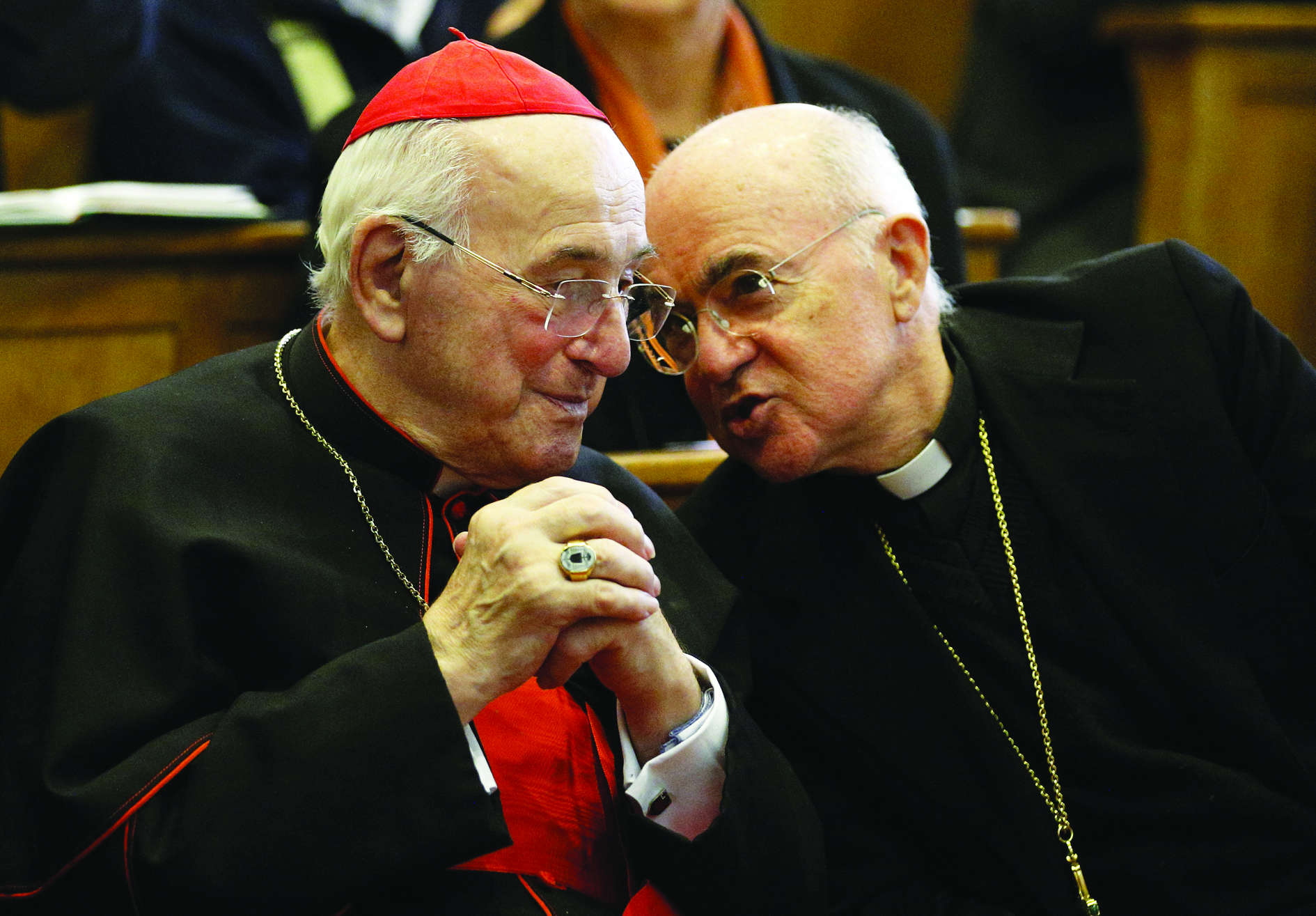
German Cardinal Walter Brandmüller (left) talks to Archbishop Carlo Maria Viganò, former apostolic nuncio to the United States (right), during a conference on St. Paul VI’s 1968 encyclical, Humanae Vitae, in Rome on October 28, 2017 (CNS photo/Paul Haring)
The decisive element of the interpretative horizon is the authentic transmission of the Faith, not the spirit of the time. This absolutely cannot mean rigidity and immobility. The way the Church keeps her eyes fixed on today must not become less. It is the present questions that demand an answer. But the elements that compose the answer can only come from Divine Revelation, offered once and for all, which the Church hands on authentically down the centuries. This transmission thus constitutes the criterion to which every new response ought to refer if it wants to be true and valid.
[…]
We must also take into account the fact that the hermeneutical horizon that has been so determined shifts and is modified in proportion to the chronological distance which the present interpreter has from the moment in which the text was created. This means that past interpretations, depending on how chronologically distant they are, may become to a greater or lesser extent claims that are now only of historical interest. This awareness is particularly important when we consider texts of the magisterial and pastoral ministry of the Church.
One could immediately object that the truth, especially the truth of divine revelation, is an eternal and immutable truth, which cannot undergo alterations… It is, however, equally true that the recognition of this eternal truth by man, who is subject to historical change, is itself subject to change, just like the man who recognizes it. That is to say: depending on the historical moment, one or another aspect of eternal truth is grasped, recognized, and understood in a new and deeper way.
Precisely for this reason, even a conciliar text, if contemplated in its spiritual and cultural context, etc., and in the light of our time, maybe understood in a new, more profound, and clearer way. To the extent that we take this concept into account in our efforts to understand the teachings of Vatican II today and for today, we will succeed in overcoming various conflicts that arise in its regard.

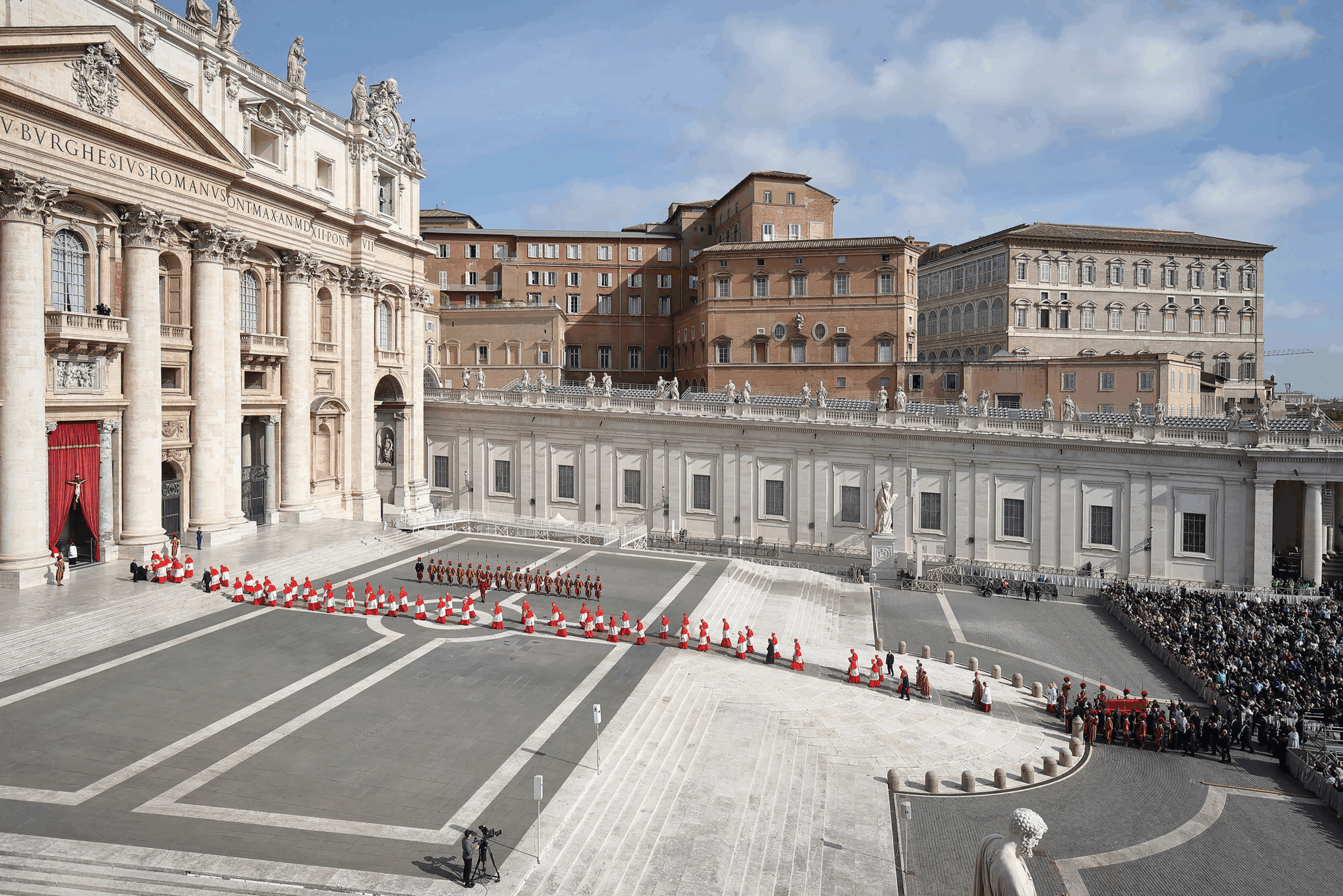
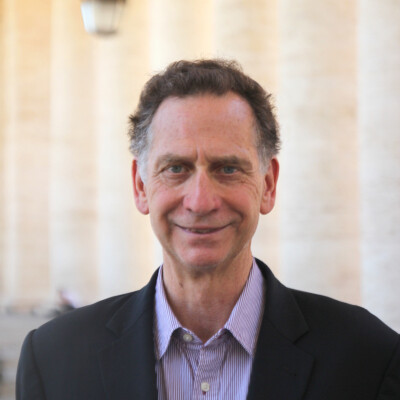



Facebook Comments